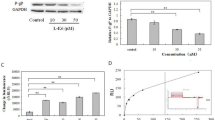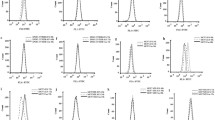Abstract
Purpose. This study evaluated the chemosensitizing effects of Pluronic P85 (P85) on cells expressing multidrug resistance-associated proteins, MRP1 and MRP2.
Methods. Cell models included MRP1- and MRP2-transfected MDCKII cells as well as doxorubicin-selected COR-L23/R cells overexpressing MRP1. Effects of P85 on cellular accumulation and cytotoxicity of vinblastine and doxorubicin were determined. Mechanistic studies characterized the effects of P85 on ATP and reduced glutathione (GSH) intracellular levels as well as MRP ATPase and glutathione-S-transferase (GST) activities in these cells.
Results. Considerable increases of vinblastine and doxorubicin accumulation in the cells overexpressing MRP1 and MRP2 in the presence of P85 were observed, although no statistically significant changes in drug accumulation in the parental cells were found. P85 treatment caused an inhibition of MRP ATPase activity. Furthermore, P85 induced ATP depletion in these cells similar to that previously reported for Pgp-overexpressing cells. In addition, reduction of GSH intracellular levels and decrease of GST activity were observed following P85 treatment. Finally, significant enhancement of cytotoxicity of vinblastine and doxorubicin by P85 in MRP-overexpressing cells was demonstrated.
Conclusions. This study suggests that P85 can sensitize cells overexpressing MRP1 and MRP2, which could be useful for chemotherapy of cancers that display these resistant mechanisms.
Similar content being viewed by others
References
C. F. Higgins. ABC transporters: from microorganisms to man. Annu. Rev. Cell Biol. 8:67-113 (1992).
D. R. Hipfner and S. P. Cole. Structural, mechanistic and clinical aspects of MRP1. Biochim. Biophys. Acta 1461:359-376 (1999).
V. Yu. Alakhov, E. V. Batrakova, and A. V. Kabanov. Hypersensitization of multidrug resistant human ovarian carcinoma cells by Pluronic P85 block copolymer. Bioconjug. Chem. 7:209-216 (1996).
A. Venne, R. Mandeville, A. V. Kabanov, and V. Yu. Alakhov. Hypersensitizing effect of Pluronic L61 on cytotoxic activity, transport, and subcellular distribution of doxorubicin in multiple drug-resistant cells. Cancer Res. 56:3626-3629 (1996).
E. Batrakova, S. Li, A. Venne, V. Alakhov, and A. Kabanov. Fundamental relationships between the composition of pluronic block copolymers and their hypersensitization effect in MDR cancer cells. Pharm. Res. 16:1373-1379 (1999).
E. V. Batrakova, S. Li, V. Y. Alakhov, A. V. Kabanov, and W. F. Elmquist. Pluronic P85 enhances the delivery of digoxin to the brain: in vitro and in vivo studies. J. Pharmacol. Exp. Ther. 296:551-557 (2001).
E. V. Batrakova, S. V. Vinogradov, V. Y. Alakhov, D. W. Miller, and A. V. Kabanov. Mechanism of pluronic effect on P-glycoprotein efflux system in blood-brain barrier: contributions of energy depletion and membrane fluidization. J. Pharmacol. Exp. Ther. 299:483-493 (2001).
D. W. Miller and A. V. Kabanov. Inhibition of multidrug resistance-associated protein (MRP) functional activity with pluronic block copolymers. Pharm. Res. 16:396-401 (1999).
E. V. Batrakova, D. W. Miller, and A. V. Kabanov. Pluronic P85 increases permeability of a broad spectrum of drugs in polarized BBMEC and Caco-2 cell monolayers. Pharm. Res. 16:1366-1372 (1999).
R. Evers, R. Sparidans, J. Beijnen, P. R. Wielinga, J. Lankelma, and P. Borst. Vinblastine and sulfinpyrazone export by the multidrug resistance protein MRP2 is associated with glutathione export. Br. J. Cancer 83:375-383 (2000).
A. Harbottle, K. Atherton, and F. C. Campbell. Role of glutathione S-transferase P1, P-glycoprotein and multidrug resistance-associated protein 1 in acquired doxorubicin resistance. Int. J. Cancer 92:777-783 (2001).
R. Evers, L. van Deemter, H. Janssen, J. Calafat, L. C. Oomen, C. C. Paulusma, R. P. Oude Elferink, F. Baas, A. H. Schinkel, and P. Borst. Drug export activity of the human canalicular multispecific organic anion transporter in polarized kidney MDCK cells expressing cMOAT (MRP2) cDNA. J. Clin. Invest. 101:1310-1319 (1998).
G. A. Thomas, S. Stewart, P. H. Rabbitts, E. D. Williams, and P. R. Twentyman. Expression of the multidrug resistance-associated protein (MRP) gene in human lung tumours and normal tissue as determined by in situ hybridisation. Eur. J. Cancer 30A:1705-1709 (1994).
E. V. Batrakova, W. F. Elmquist, D. W. Miller, V. Y. Alakhov, and A. V. Kabanov. Mechanism of sensitization of MDR cancer cells by Pluronic block copolymers: Selective energy depletion. Br. J. Cancer 85:1987-1997 (2001).
S. W. de Laat and M. Shinitzky. Microviscosity modulation during the cell cycle of neuroblastoma cells. Proc. Natl. Acad. Sci. USA 74:4458-4461 (1977).
H. Hamada. Characterization of the ATPase activity of the Mr 170,000 to 180,000 membrane glycoprotein (P-glycoprotein) associated with multidrug resistance in K562/ADM cells. Cancer Res. 48:4926-4932 (1988).
Y. Taguchi, Y. Takada, T. Komano, and K. Ueda. Anti-cancer drugs and glutathione stimulate vanadate-induced trapping of nucleotide in multidrug resistance-associated protein (MRP). FEBS Lett. 401:11-14 (1997).
P. Druekes and D. Palm. Photometric microtiter assay of inorganic phosphate in the presence of acid-labile organic phosphates. Analytical Biochem 230:173-177 (1995).
M. P. Draper and S. B. Levy. Active efflux of the free acid form of the fluorescent dye 2′,7′-bis(2-carboxyethyl)-5(6)-carboxyfluorescein in multidrug-resistance-protein-overexpressing murine and human leukemia cells. Eur. J. Biochem. 243:219-224 (1997).
W. H. Habig and W. B. Jakoby. Glutathione S-transferases. The first enzymatic step in mercapturic acid formation. J. Biol. Chem. 249:7130-7139 (1974).
M. Ferrari and A. M. Isetta. MTT colorimetric assay for testing macrophage cytotoxic activity in vitro. J. Immunol. Methods 131:165-172 (1990).
R. Evers, A. J. Smith, L. van Deemter, M. de Haas, and P. Borst. Inhibitory effect of the reversal agents V-104, GF120918 and Pluronic L61 on MDR1 Pgp-, MRP1-and MRP2-mediated transport. Br. J. Cancer 83:366-374 (2000).
H. S. Garewal, R. B. Schifman, and A. Celniker. ATP assay: ability to distinguish cytostatic from cytocidal anticancer drug effects. J. Natl. Cancer Inst. 77:1039-1045 (1986).
V. I. Slepnev, A. N. Gubin, E. V. Batrakova, V. Yu. Alakhov, and A. V. Kabanov. Micelles of poly(oxyethylene)-poly(oxypropylene) block copolymer (pluronic) as a tool for low-molecular compound delivery into a cell: phosphorylation of intracellular proteins with micelle incorporated [gamma-32P]ATP. Biochem. Int. 26:587-595 (1992).
R. Regev and G. D. Eytan. Membrane fluidization by ether, other anesthetics, and certain agents abolishes P-glycoprotein ATPase activity and modulates efflux from multidrug-resistant cells. Eur. J. Biochem. 259:18-24 (1999).
W. Hagmann, J. Konig, M. Frey, H. Zentgraf, and D. Keppler. Purification of the human apical conjugate export pump MRP2 reconstitution and functional characterization as substrate-stimulated ATPase. Eur. J. Biochem. 265:281-289 (1999).
N. Rapoport and A. A. Timoshin. Effect of a polymeric surfactant on electron transport in HL-60 cells. Arch. Biochem. Biophys. 384:1000-1008 (2000).
E. V. Batrakova, V. Y. Alakhov, D. W. Miller, and A. V. Kabanov. Optimal structure requirements for pluronic block copolymers in modifying P-glycoprotein drug efflux transporter activity in bovine brain microvessel endothelial cells. J. Pharmacol. Exp. Ther. 304:845-854 (2003).
Author information
Authors and Affiliations
Corresponding author
Rights and permissions
About this article
Cite this article
Batrakova, E.V., Li, S., Alakhov, V.Y. et al. Sensitization of Cells Overexpressing Multidrug-Resistant Proteins by Pluronic P85. Pharm Res 20, 1581–1590 (2003). https://doi.org/10.1023/A:1026179132599
Issue Date:
DOI: https://doi.org/10.1023/A:1026179132599




